ACKNOWLEDGMENTS
I owe a huge debt of gratitude to more people than I can name for helping me through the extremely difficult process of this book. I owe a world of apology to everyone I blew off while I was working on it, and a beer to half of Montrose. If I listed everyone who helped with advice, knowledge, or just by being in the right place at the right time, I would never be finished. So Ill keep it short.
My family for their peculiar way of showing love.
My friends for their understanding.
And above all Kim Grant, my editor, for doing the one thing no one else would do: give me a chance.
BIBLIOGRAPHY
As J. Frank Dobie wrote in the WPA Guide to Texas in 1939, Almost contemporary with the discovery of Texas by Europeans was the beginning of its literature. It may seem strange to some that books on Texas predate the existence of the state of Texas by three hundred years. However, you have to remember that for centuries, going to Texas and surviving the trip was considered a feat worth writing about. The first book to discuss Texas was Cabeza de Vacas travel narrative, La Relacin de Cabeza de Vaca, in which he describes being held captive by Indians and making his escape. A full copy of this amazing travel narrative can be found online at www.library.txstate.edu/swwc/cdv/index.html. The version at this site is a very good translation of the 1555 edition, although it should be noted that the first edition was published eight years earlier with 42 more words in the title. For the next 450 years books were continually published about Texas. The incredible span of time involved in Texas literature, plus the vast amount of books published in that time, helps to explain why there are more books about Texas than almost all the other states combined. In fact, there are so many that booksellers created a category specifically for them: Texana. To try to list all of them would require a book of no less than 700 pages. So I picked some of my favorites that are still in print, an act that will inevitably upset some. There are many more available at university libraries and rare bookstores.
Barthelme, Donald. Snow White. New York: Simon & Schuster, 1965 (187 pp., $12.00). It may seem odd that this imaginative reworking of the classic fairy tale by one of the late-20th centurys premiere postmodern writers would have anything to do with Texas. Shows how little you know. Barthelme grew up in Houston. He was the director of the Houston Contemporary Arts Museum, helped found the University of Houston Creative Writing Program (one of the first in the nation), and lived in Houston most of his life. His writings may not directly reflect Houston, but they still should be read as a way to understand Houston.
Bickerstaff, Steve. Lines in the Sand: Congressional Redistricting in Texas and the Downfall of Tom Delay. Austin: University of Texas Press, 2007. (472 pp., $34.95). This much-needed book details the downfall of the most powerful man in Texas politics in a readable manner. The author is a UT law professor and former special assistant attorney general.
Bradfield, Bill, and Clare Bradfield. Muleshoe & More. Houston: Gulf Publishing Co., 1999 (218 pp. $15.95). This helpful dictionary/encyclopedia will help keep you from mangling some of the more difficult and unusual place names in Texas. It is also filled with the interesting bits of trivia that make a long car ride a little bit more enjoyable.
Borders, Gary B. A Hanging in Nacogdoches: Murder, Race, Politics and Polemics in Texass Oldest Town, 18701916. Austin: University of Texas Press, 2006 (239 pp.). This book is important, not because it tells the story of James Buchanan, a black man who was sentenced to death for a crime he didnt commit. Hundreds of those cases happened and are still happening throughout the South and elsewhere. No, it is important because it describes why those cases happen. It gets into the power politics behind racism, shows how national trends can manifest themselves at the lowest levels, and how the personal rivalries of two people can lead to the death of a third.
Brands, H. W. Lone Star Nation: The Epic Story of the Battle for Texas Independence. New York: Random House, 2005 (582 pp., $16.95). This is perhaps the most recent and best book on the Texas war for independence, primarily because it spends as much time on the Mexicans as it does on the Texans. The author, a UT history professor, has a novelists grasp of pacing and character. This moves into the realm of what Stephen Ambrose describes as historians writing for a popular audience. Personally I think it a good thing because it means that he knows how to tell a story.
Byrd, Sigman. Sig Byrds Houston. New York: Viking Press, 1955 (250 pp.). This is the best book ever written about Houston. The author was a reporter for the now-defunct Houston Post back in the forties and fifties. He worked the metro beat, writing about the city and its peoplethe musicians, junkies, sailors, cantina owners, prostitutes, and blacksmiths (yes, Houston still had blacksmiths operating in 1954). His writing was beautiful, his eye fantastic. He was the best newspaperman Houston ever produced, and this book should be read by everyone who lives, visits, drives through, or even hears about Houston. It should be passed out at the airport, placed next to the Gideon Bibles in the citys hotels, and kept in every home. It is that good.
Campbell, Randolph B. Gone to Texas: A History of the Lone Star State. New York, Oxford: Oxford University Press, 2003 (500 pp., $35.00). This historical overview takes readers from the arrival of the first humans up to the beginning of the Cold War. It keeps the myths pretty much intact. The heroes stay heroes, and the villains stay villains, and it never lingers long enough to get boring or uncomfortable.
Clayton, Lawrence, and Joe W. Specht, eds. The Roots of Texas Music. College Station: Texas A&M University Press, 2003 (235 pp., $19.95). This book runs the gamutwith chapters on jazz, country, blues, zydeco, classical, gospel, and Chicano, Czech, and Polish contributionsall of which are written by recognized authorities on the subject. It is a very interesting read and should be sold along with every musical instrument in the state of Texas.
Cohen, Rebecca S. Art Guide Texas: Museums, Art Centers, Alternative Spaces, and Nonprofit Galleries. Austin: University of Texas Press, 2004 (464 pp., $24.95). This guide is noble in its attempt and ambition, but sadly limited in its coverage. It favors the big established venues and not the fringe galleries where the really interesting stuff is going on or the public art spaces. This is a good introduction, but it is no way complete. Hopefully an expanded edition will be coming soon.
Davis, Steven L. Texas Literary Outlaws: Six Writers in the Sixties and Beyond. Fort Worth, TX: TCU Press. 2004 (511 pp., $35.00). This huge, rollicking, riotous book deals with the lives of the six writers who changed the very notion of what Texas is. Bud Shrake, Larry L. King, Billy Lee Brammer, Gary Cartwright, Dan Jenkins, and Peter Genttheir names may not be household words, but their writings are. They helped found Texas Monthly and wrote things like Best Little Whorehouse in Texas and North Dallas Forty. They redefined what it meant to be a writer in Texas, partied with Willie Nelson, and forged a literary community while doing it.
Dobie, J. Frank. Tales of Old Time Texas. Austin: University of Texas Press, 1928. This collection of folktales is by one of the greatest Texas writers of the early 20th century. Dobies style is indicative of that period, as is the typography in the book and the illustrations.



